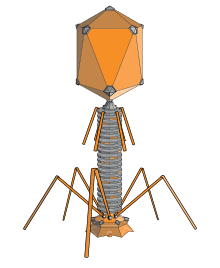
Back عاثية Arabic Bakteriofaq Azerbaijani Бактэрыяфагі Byelorussian Бактериофаг Bulgarian ব্যাকটেরিওফাজ Bengali/Bangla Bakteriofag BS Bacteriòfag Catalan ڤایرۆسی بەکتریا خۆرکە CKB Bakteriofág Czech Bakteriofag Danish



A bacteriophage (/bækˈtɪərioʊfeɪdʒ/), also known informally as a phage (/ˈfeɪdʒ/), is a virus that infects and replicates within bacteria and archaea. The term is derived from Ancient Greek φαγεῖν (phagein) 'to devour' and bacteria. Bacteriophages are composed of proteins that encapsulate a DNA or RNA genome, and may have structures that are either simple or elaborate. Their genomes may encode as few as four genes (e.g. MS2) and as many as hundreds of genes. Phages replicate within the bacterium following the injection of their genome into its cytoplasm.
Bacteriophages are among the most common and diverse entities in the biosphere.[2] Bacteriophages are ubiquitous viruses, found wherever bacteria exist. It is estimated there are more than 1031 bacteriophages on the planet, more than every other organism on Earth, including bacteria, combined.[3] Viruses are the most abundant biological entity in the water column of the world's oceans, and the second largest component of biomass after prokaryotes,[4] where up to 9x108 virions per millilitre have been found in microbial mats at the surface,[5] and up to 70% of marine bacteria may be infected by bacteriophages.[6]
Bacteriophages were used from the 1920s as an alternative to antibiotics in the former Soviet Union and Central Europe, as well as in France.[7][8] They are seen as a possible therapy against multi-drug-resistant strains of many bacteria (see phage therapy).[9][10][11][12]
Bacteriophages are known to interact with the immune system both indirectly via bacterial expression of phage-encoded proteins and directly by influencing innate immunity and bacterial clearance.[13] Phage–host interactions are becoming increasingly important areas of research.[14]
- ^ Padilla-Sanchez V (2021). "Structural Model of Bacteriophage T4". WikiJournal of Science. 4 (1): 5. doi:10.15347/WJS/2021.005. S2CID 238939621.
- ^ McGrath S, van Sinderen D, eds. (2007). Bacteriophage: Genetics and Molecular Biology (1st ed.). Caister Academic Press. ISBN 978-1-904455-14-1.
- ^ LaFee S, Buschman H (25 April 2017). "Novel Phage Therapy Saves Patient with Multidrug-Resistant Bacterial Infection". UC Health – UC San Diego. Retrieved 13 May 2018.
- ^ Suttle CA (September 2005). "Viruses in the sea". Nature. 437 (7057): 356–361. Bibcode:2005Natur.437..356S. doi:10.1038/nature04160. PMID 16163346. S2CID 4370363.
- ^ Wommack KE, Colwell RR (March 2000). "Virioplankton: viruses in aquatic ecosystems". Microbiology and Molecular Biology Reviews. 64 (1): 69–114. doi:10.1128/MMBR.64.1.69-114.2000. PMC 98987. PMID 10704475.
- ^ m Prescott L (1993). Microbiology. Wm. C. Brown Publishers. ISBN 0-697-01372-3.
- ^ Bunting J (1997). "The Virus that Cures". BBC Horizon. BBC Worldwide Ltd. OCLC 224991186. – Documentary about the history of phage medicine in Russia and the West
- ^ Borrell B, Fishchetti V (August 2012). "Science talk: Phage factor". Scientific American. pp. 80–83. JSTOR 26016042.
- ^ Kortright KE, Chan BK, Koff JL, Turner PE (February 2019). "Phage Therapy: A Renewed Approach to Combat Antibiotic-Resistant Bacteria". Cell Host & Microbe. 25 (2): 219–232. doi:10.1016/j.chom.2019.01.014. PMID 30763536. S2CID 73439131.
- ^ Gordillo Altamirano FL, Barr JJ (April 2019). "Phage Therapy in the Postantibiotic Era". Clinical Microbiology Reviews. 32 (2). doi:10.1128/CMR.00066-18. PMC 6431132. PMID 30651225.
- ^ González-Mora A, Hernández-Pérez J, Iqbal HM, Rito-Palomares M, Benavides J (September 2020). "Bacteriophage-Based Vaccines: A Potent Approach for Antigen Delivery". Vaccines. 8 (3): 504. doi:10.3390/vaccines8030504. PMC 7565293. PMID 32899720.
- ^ Keen EC (2012). "Phage therapy: concept to cure". Frontiers in Microbiology. 3: 238. doi:10.3389/fmicb.2012.00238. PMC 3400130. PMID 22833738.
- ^ Cite error: The named reference
Popescuwas invoked but never defined (see the help page). - ^ Stone E, Campbell K, Grant I, McAuliffe O (June 2019). "Understanding and Exploiting Phage-Host Interactions". Viruses. 11 (6): 567. doi:10.3390/v11060567. PMC 6630733. PMID 31216787.